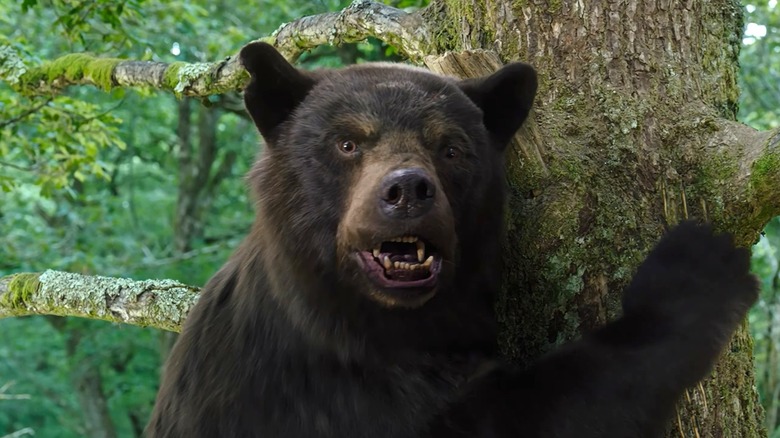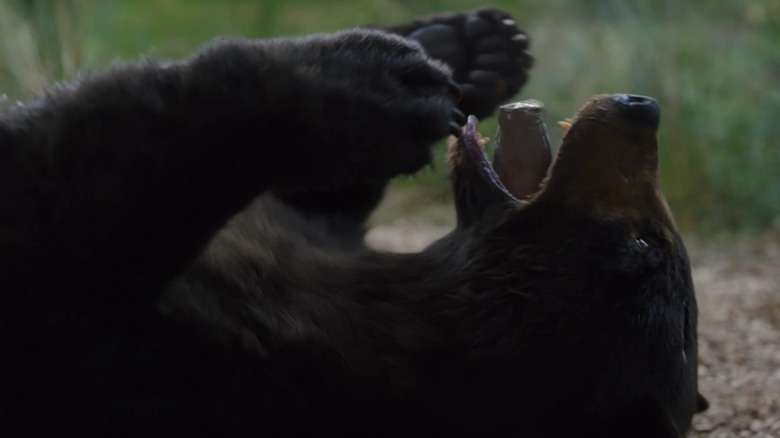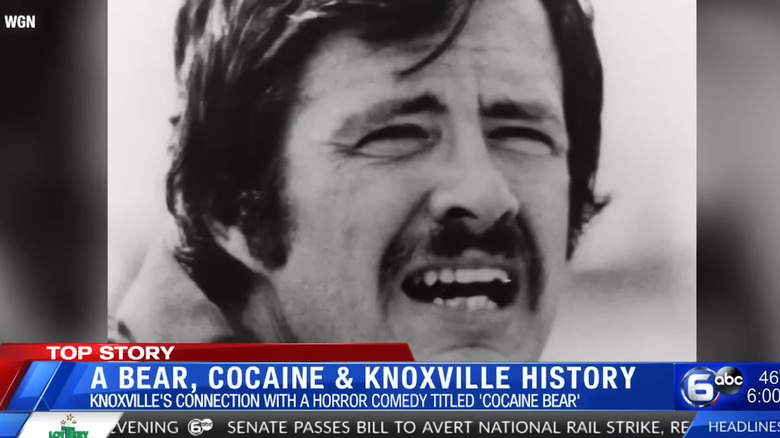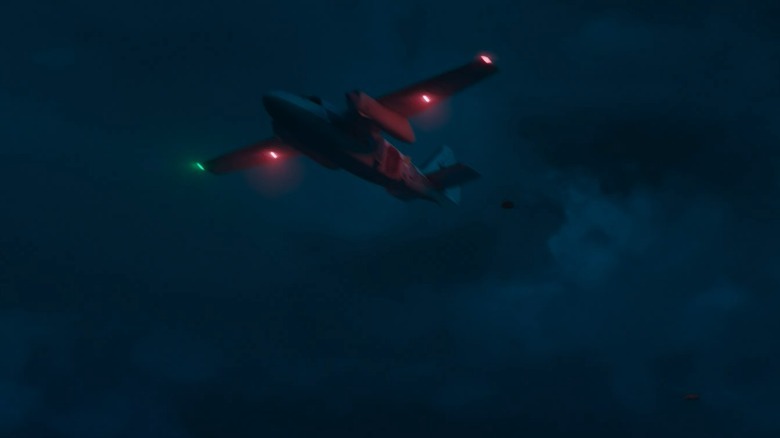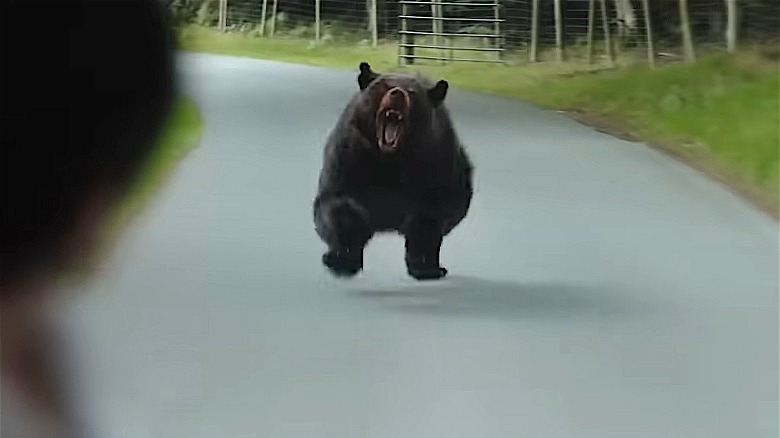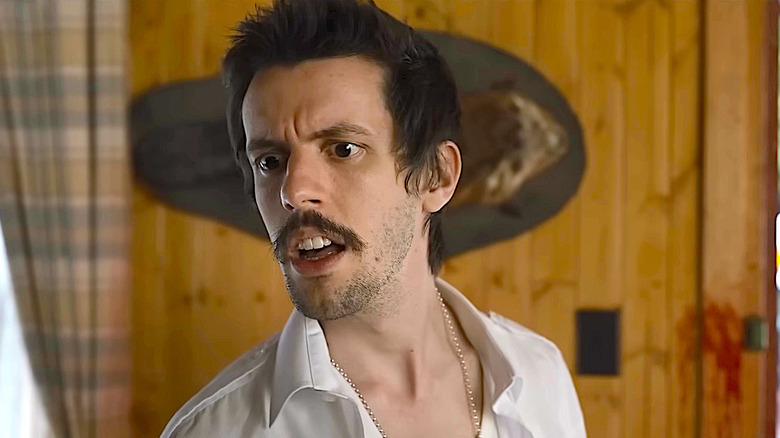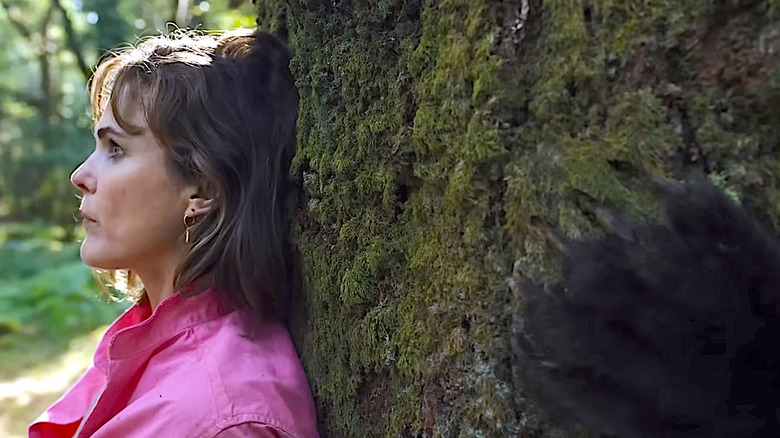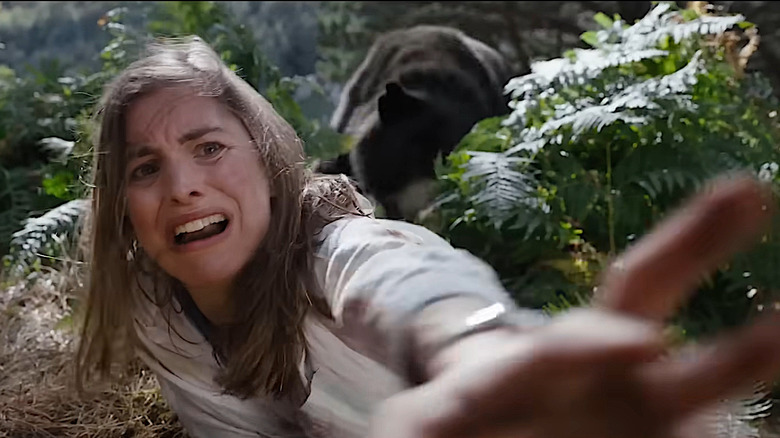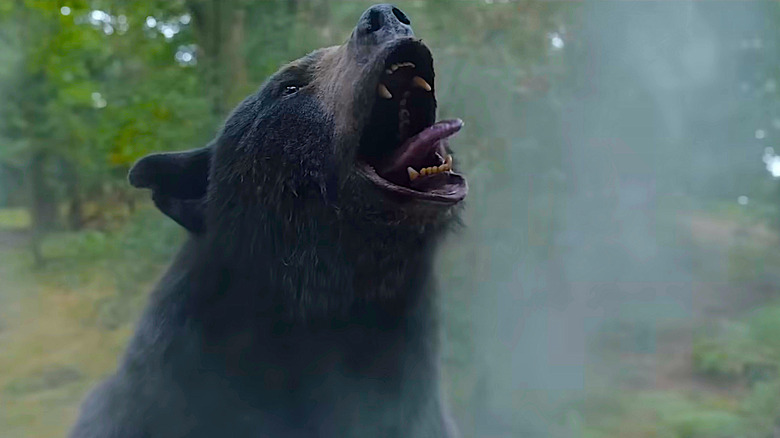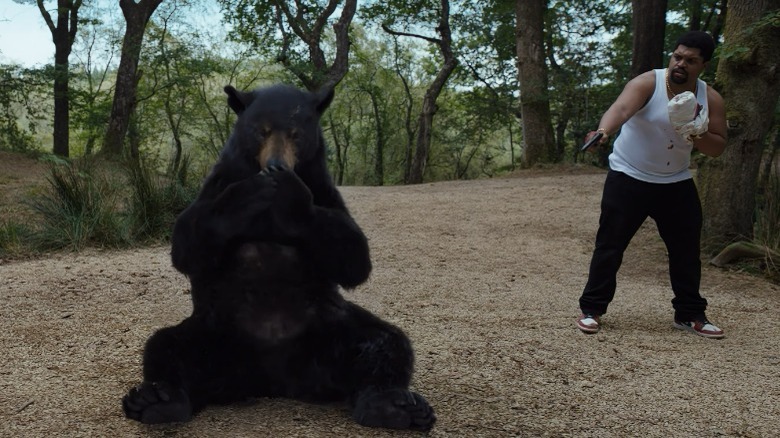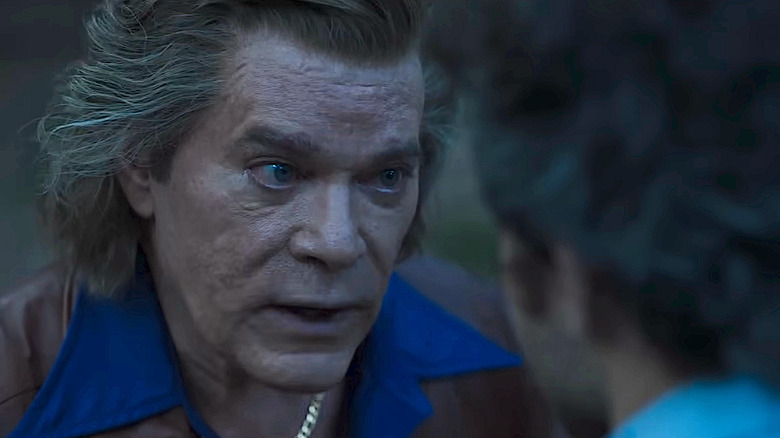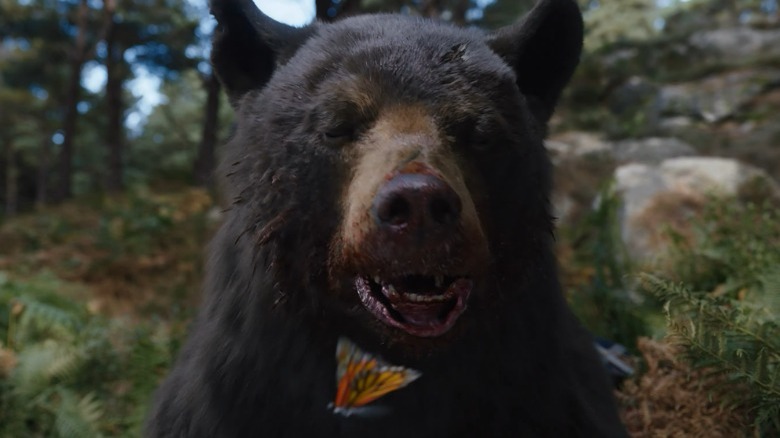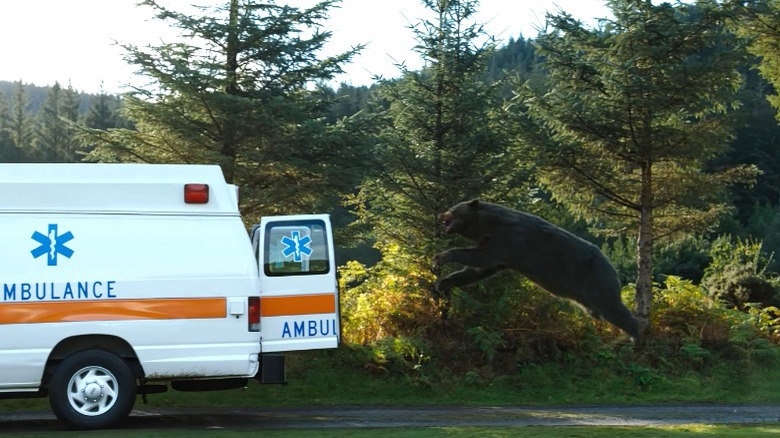Everything Cocaine Bear Doesn't Tell You About The True Story
"Cocaine Bear" is a hilarious and horrific killer bear thrill ride inspired by true events — but just how close does it stick to those events? Did Pablo Escobear really maul a bunch of innocent (and not-so-innocent) hikers? Did kids really discover the bear's stash and sample the product? Did the drug dealer who fell from the sky along with millions of dollars of cocaine really have that great of a mustache?
Director Elizabeth Banks and screenwriter Jimmy Warden take a bit of creative license with everybody's favorite sky-high mama bear. Meaning, there's only about a gram of reality to the movie "Cocaine Bear," compared to its mountain of high-octane emotional truth. Yes, a drug dealer did parachute out of the plane and die. No, the bear didn't kill anybody. Still, the real cocaine bear's story — and the story behind the making of the movie — has to be seen to be believed.
Though he only gets a brief cameo, the doomed drug dealer who bites the big one in the film's first five minutes is based on Andrew Thornton, and he's an even wilder real-life character than the bear. Beware of spoilers and read on to learn more about this cocaine cowboy of the sky — plus everything "Cocaine Bear" doesn't tell you about the true story.
You're probably wondering how I ended up in this situation
"Cocaine Bear" opens with Andrew Thornton trying to save his life by whipping bricks of cocaine into the sky. The doomed drug runner is trying to both make a scheduled drug drop and cut weight from a heavy load in a last-ditch attempt to keep his Cessna twin-engine 404 in the air. Spoiler alert: it doesn't work out, in the movie or in real life.
Thornton — played to mustachioed perfection by Matthew Rhys of "Perry Mason" fame — meets his end after leaping from the plane. Thornton is found dead on the ground, his body wrapped in a bulletproof vest and strapped with thousands of dollars in cash and millions in cocaine. Thornton is also packing a knife and some Krugerrands for good measure. So how did he end up falling from the sky?
In real life, Thornton was a former Army paratrooper. According to a 1985 profile in The Washington Post about him and his schemes, Thornton was also an expert at "pulling low" — releasing his parachute ripcord at altitudes under 2,000 feet. Thornton's thrill-seeking didn't stop there. He was a cop (and lawyer) who turned dirty while working for the DEA. Thornton stole drugs from evidence and started selling them, and later began smuggling on a larger scale. However, Thornton's final drug run clearly proves bigger isn't always better when it comes to the cocaine game.
Every day I'm smuggling
The real Andrew Thornton was packing more than 70 pounds of cocaine on his person when he died, which was valued at well over $10 million. Even if you're not the betting type, you can probably guess that he wasn't just holding all that for a friend. Despite (or perhaps because of) this "Cocaine Bear" kickstarter's origins as a narcotics officer, Thornton became a kingpin of Kentucky drug running. Together with fellow officer Bradley Bryant, Thornton created a security firm that fronted his drug and weapons-smuggling business.
This syndicate, known as The Company, was a Kentucky outfit with friends in extremely high places — namely the Chagra brothers. When one of the brothers, Jimmy Chagra, was facing a life sentence for drug smuggling in the '70s, he later stood trial for hiring Charles Harrelson (Woody Harrelson's father) to take out the federal judge overseeing the case. Investigator Sally Denton also posits in her book "The Bluegrass Conspiracy" that The Company was involved in a mutually beneficial relationship with CIA operatives who supported the Iran-Contra affair.
Bryant and Thornton often invoked CIA connections over the years, possibly to escape harsh punishments when caught red-handed for theft or smuggling. While no conclusive link was ever proven, Denton points out that both Thornton and Bryant kept CIA contacts in their private address books in case of emergency and that both had a CIA phone number written in their address books.
Cocaine plane
Everyone is concerned about the bear in "Cocaine Bear" — but what about the cocaine plane? The Cessna 404 that Andrew Thornton put on autopilot and abandoned mid-air crash-landed deep in the North Carolina mountains. The location of the plane, as well as Thornton's body in Tennessee and the hundreds of pounds of cocaine found in Georgia, helped authorities zero in on a cocaine-smuggling trail.
While some may gasp at the idea of a man leaping from a moving plane to a violent death, others may have enjoyed a sense of relief or victory — especially if they dealt with Thornton in court before, like Fresno assistant U.S. Attorney Brian Layton. In fact, Layton told the Los Angeles Times in 1985, "I'm glad his parachute didn't open. I hope he got a hell of a high out of that (cocaine.)"
While the problematic parachutist didn't survive this particular run, many other smugglers escaped detection. In 1985, The New York Times reported that "Almost two-thirds of all cocaine smuggled into the United States comes in on small, private aircraft" like the one Thornton shimmied through and leapt from.
Killer instincts
Before Andrew Thornton de facto killed the "Cocaine Bear," he was suspected of what investigator and author Sally Denton described in the Chicago Tribune as "vendetta deaths." Thornton had a reputation for paranoia, doomsday prepping, and a soldier of fortune attitude, which might have culminated in a low-key murderous rampage that would make even Cokey the Bear raise an eyebrow.
In her book "The Bluegrass Conspiracy," Denton details how Thornton attempted to evade arrest for marijuana smuggling first by becoming a fugitive, then by staging a gunshot attack against himself while wearing a bulletproof vest. Authorities saw through Thornton's ruse and convicted him on marijuana conspiracy charges. While police might have hoped for the proverbial buck to stop there, Thornton possibly took that buck and turned it into buckshot.
According to Denton, years after Thornton's conviction, several attorneys and witnesses who had worked against Thornton's interests turned up violently dead. One such "victim" was former Kentucky DEA head honcho Harold Wade Brown, a close friend and drug-smuggling colleague of Thornton's who could have spilled the beans on a secret drug lab the pair worked out of. Brown's death was initially ruled a suicide. Gunshots, slit throats, and strangulation — all in a day's work for a man who didn't think twice about killing an innocent bear with cocaine.
It was justified
Andrew Thornton may have lived life like a maniacal and murderous drug pirate, but he was born into a good Kentucky thoroughbred horse family. This Bourbon County blueblood traded horse-raising for hellraising and grew more paranoid and potently criminal with age until his death at 40. Thornton's grisly (bear) death and his involvement with the drug-and-gun smuggling ring The Company didn't just inspire the movie "Cocaine Bear" — it was also a Season 4 arc of FX's "Justified."
In "Justified," Andrew Thornton is transformed into Drew Thompson, a drug-running parachutist who "dies" like the real Thornton but then returns to the Kentucky crime scene with a new name – Shelby Parlow — and a new lease on life. This iteration of Thornton is played by Jim Beaver (of "Deadwood" and "Supernatural" fame), and without giving away too much, the character honors its namesake with his surprising nature.
In less fictional terms, Thornton's true stories are also the subject matter of a two-part "The FBI Files" episode called "Dangerous Company," an episode of the investigative series "Dominick Dunne's Power, Privilege, and Justice," a 2022 episode of "NCIS," and Episode 268 of the podcast "My Favorite Murder," "All-Stars of 7th Grade."
The second man
Behind every "Cocaine Bear" is a cocaine man, and behind every cocaine man is a karate instructor slash bodyguard. Bill Leonard was Andrew Thornton's co-pilot on the fateful cocaine bear flight, but he lived to tell the tale — and to deny many others.
Leonard is charged with being Thornton's co-conspirator in all smuggling pursuits by Sally Denton in her book "The Bluegrass Conspiracy," but Leonard has a story and he's sticking to it: Thornton tricked him into drug smuggling. Also, he ate a parrot in Montería and got food poisoning. While eating tropical birds may not be the rock-solid defense Leonard thinks it is, he also claimed in a 1990 Knoxville News Sentinel interview that Thornton surprised him with the Colombian smuggling plan on what Leonard thought was a quick Bahamas pleasure trip.
Leonard claims that both he and Thornton suspected they were being pursued by federal agents, which prompted their plans of escape. Leonard started ditching bricks of cocaine, infuriating Thornton — until the two looked at each other and busted up laughing. While Leonard made it out of the plane intact, Thornton made it into "Cocaine Bear."
A beary special friend
Andrew Thornton's last girlfriend, Rebecca Sharp, was the target of intense questioning after his death by authorities who hit her with hefty drug conspiracy charges. Sharp, a paralegal, was treated as Thornton's accomplice in the drug run that would take his life and the life of the real "Cocaine Bear." Sharp faced a maximum 70-year sentence and a $780,000 fine.
The AP reported that Sharp claimed she was coerced to the point of tears by undercover agents, who intimated that Colombian forces would exact retribution against Sharp for Thornton's loss of the 880 lb run of cocaine. Agents pressed hard to learn the location of the lost cocaine, but Sharp insisted she had no idea. She walked on bail set for $50,000.
Ultimately, charges against Sharp were dismissed, but another possible co-conspirator of Thornton's wasn't so lucky. David Williams owned the plane Thornton crashed. Williams and his plane full of 16 sky-diving enthusiasts were killed due to a sabotaged plane in September 1985. The FBI suspected Williams was targeted by the Colombian arm of The Company as payback for Thornton botching their 880-lb cocaine delivery. An unnamed agent was quoted in 1985 as saying, "DEA has been watching these boys for a long time but couldn't pin anything on them because they were so good. They were in drug smuggling for the kicks. Both of them had money and neither of them used the stuff."
Blood, guts, and Pablo Escobear
The real-life and movie magic "Cocaine Bear" goes by many names — Cocaine Bear, Pablo Escobear, and Cokey the Bear. However, while the movie bear always needs more cowbell in the form of blood and cocaine, the real-life cocaine bear was the true horror movie victim.
Cokey did pull a "Scarface" on all the snow in Chattahoochee, but she didn't eat any hikers. In fact, she didn't so much as nibble a single powdered nose before her bad trip took its fatal toll. In addition to being the star of her own horror-comedy, Cokey also got her own de facto obit in The New York Times. Kentucky for Kentucky, the gift shop that now houses the taxidermied Cocaine Bear, reached out to the bear's initial medical examiner at the Georgia Bureau of Investigation.
"Its stomach was literally packed to the brim with cocaine," the examiner told KY for KY. "There isn't a mammal on the planet that could survive that. Cerebral hemorrhaging, respiratory failure, hyperthermia, renal failure, heart failure, stroke. You name it, that bear had it." While the bear looked intact from the outside, all of its internal organs had exploded. While the lack of internal organs must make taxidermy a snap, make sure to pour a little honey out for the real Cocaine Bear's gruesome fate. How shocking that Cokey wasn't the face of "D.A.R.E." in the '90s — how effective would "B.E.A.R." be for kids to learn when it comes to drugs, just say no?
Pay your respects to the Cocaine Bear
The real-life "Cocaine Bear" is the patron saint of eating something you shouldn't. It's only fitting that this lack-of-impulse control icon, this champion of self-destructive curiosity, and this creature of cocaine habits was turned into a memorial of sorts.
According to the current holders of Cocaine Bear, the Kentucky for Kentucky Fun Mall and gift shop, the bear's medical examiner thought it would be a shame to let her hide go to waste. He got the bear taxidermied and donated it to the Chattahoochee River National Recreation area. From here, the bear was sold, pawned, and regifted through a series of hands — including those belonging to (possibly, maybe, not at all definitely) Waylon Jennings.
The KY for KY team ultimately traced the location of the bear to the wife of Zhu T'Ang, who ran a Chinese medicine shop in Reno, NV. After he passed, T'Ang's wife didn't know what to do with the bear and didn't know its history until KY for KY shared it with her. She agreed to send the store the bear as their new mascot for only the price of shipping. The shop has its own line of Cocaine Bear merch, but they're not limited to apparel bearing the likeness of the beast on blow — they also sell gold-plated chicken bone jewelry.
Craic cocaine
While the real "Cocaine Bear" was found where the movie is set, in the Georgia mountains, the movie was filmed in another land famous for its horrifying and beautiful forests: Ireland. The Emerald Isle was also a primary shooting location for "Game of Thrones," which starred Kristofer Hivju as Tormund Giantsbane — seen here as a hiker who loses his girlfriend to the bear at the beginning of the movie.
Principal photography for "Cocaine Bear" took place in Powercourt, Barnislagan Woods, Avoca, and the Wicklow Mountains. Oddly enough, this area is sometimes referred to as Ireland's "vanishing triangle," as victims of Dublin crimes are known to be dumped in the mountains. Still, it's not all mythical forests and hideous murder in Ireland — there are also genealogical discoveries, like the one Ray Liotta made while filming.
Director Elizabeth Banks told Esquire that Liotta took a big liking to Ireland, and during his blood-covered wrap speech the adopted Liotta told the cast and crew, "I recently found out that I am actually mostly Irish. So this trip has been so special to me because I didn't understand the connection that I actually had to this place and to the Irish people. And everybody's been so nice."
Bear-ied treasure
"Cocaine Bear" went on a rampage opening weekend and snorted up more box office winnings than anyone expected. Director Elizabeth Banks' film even gently pawed her "Wet Hot American Summer" co-star Paul Rudd's film "Ant-Man and the Wasp: Quantumania" out of the lead. "Cocaine Bear" is opening on the strength of a viral trailer, and its healthy performance so far is both a testament to the film's catchy escapist caper energy and proof that so-called "flop" directors don't merit a quick write-off.
Mixed genres, horror-comedy, and tonal shifts are three elements that make a movie glorious when they work and dead in the water when they don't. Banks has flopped before, notably with "Charlie's Angels," and is a female director, already only fractionally represented (and supported) in Hollywood. Banks told Variety "Cocaine Bear" could end her career and that "Hollywood is not handing out paydays to women in their 40s and 50s. As I've gotten older, I've realized how slow progress is. I can only push so much, but I will keep pushing." If the drugs Banks deals continue to be like "Cocaine Bear," here's to Banks pushing forever.
Screenwriter Jimmy Warden was also shocked by the film's success and told Variety he never thought anyone would make the film. However, Warden has worked with producers Phil Lord and Christopher Miller since their "21 Jump Street" days, and a movie with the title "Cocaine Bear" ultimately proved too good to resist.
Scare Bears
Most of "Cocaine Bear'" $35 million budget paid for the rendering of the actual cocaine bear via Weta FX, the visual effects company founded by Peter Jackson. While CGI Cokey is pulse-poundingly real thanks to the tireless and inventive efforts of the visual effects team, one particular member was key to her creation: the man behind the bear, Allan Henry.
Henry is a motion capture actor and stuntman who has worked extensively in the "Planet of the Apes" franchise, "Avengers: Endgame," and "Jungle Book." The face behind the cocaine bear was often covered in mo-cap dots and a helmet with an extended snout to represent the giant size of Ms. Escobear's head, while Henry's body was outfitted with a rig that could help him move more like a bear. Henry also wore special "hand stilts" that allowed him to "go on quadruped," aka running on all fours as part-man, part-beast. That's actually Henry physically running after the ambulance, wearing a coat of expertly-rendered visual effects.
Henry tells IndieWire, "It's a hell of a core workout, that's for sure," Henry said. "The whole extension was about a meter long, but where my hand was about half a meter down, they were about 500 or 600 millimeters up. But what that means is that I can essentially be on all fours without compromising too much of my own structure, so that I can still breathe, and I still have flexibility and still have movement." Running at full tilt while a hilarious cast screams and cracks jokes down at him sounds like a tough job — but fans of the movie can rejoice that Henry could grin and bear it.
